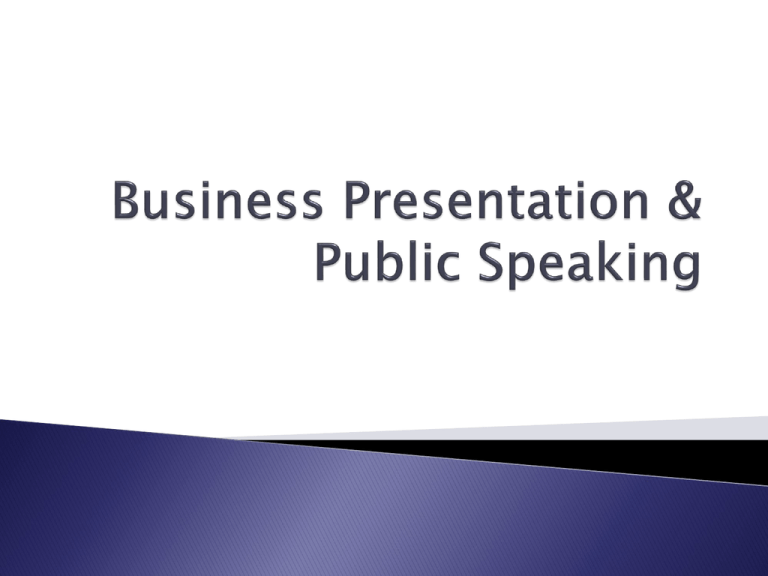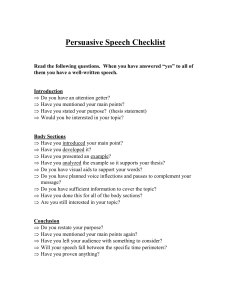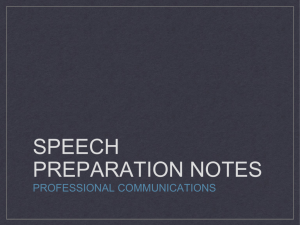presentation session v
advertisement

For most managers it’s an occupational hazard to sit through regular presentations whether as a member of the audience or as a speaker trying to spice up a pitch Your ability to effectively communicate with your audience and engage them directly reflects on your company and YOU Fortunately, public speaking is something that can be studied, polished and perfected with tenacity and persistence Sales Managers & Financial Managers Brand Managers Division Heads & Shop Floor Managers R&D Team •Potential Customers •Management •Senior Managers •Management Points Of Difference Business Presentations Public Speaking Aim of speakers To give the audience what they know they need To give the audience what they believe they want Type of audience Generally homogeneous in terms of their knowledge, area of academic or professional interest, etc Mostly heterogeneous Expectations of audience Complete details about the topic Do not expect a lot of details Amount of information More Less Level of interaction More: as the audience wishes to understand the topic thoroughly Less: as a general understanding is desired by the audience Planning Structuring Organising/Outlining Delivery Through effective preparation you will be able to address all the questions and doubts about your speech before they arise Content and delivery of your speech depend upon the following five factors: 1. 2. 3. 4. 5. Occasion Audience Purpose Thesis Material Planning Occasion Audience Facilities, Time & Context Positions, Personal preferences, demographic characteristics Purpose Thesis Material Research, surveys, interviews (general/ specific) Inform, persuade, entertain, train, sell SOP, Central idea Helps make messages more comprehensible Keeps the audience happy Boosts your image as a speaker Helps avoid the discourse becoming disjointed/choppy Tell the audience what you want to tell them, tell them what you wanted to tell them and then tell them what you have told them In other words, format the presentation thus: ◦ Introduction ◦ Main Body ◦ Conclusion Quotation Startling statement Question Humour Reference to audience Story/Personal experience Attention Getters Reference to occasion Thesis Statement Audience Adaptation Credibility Statement Preview Message-based approach Preparation Incubation Be creative Illumination Mind map the speech Verification Signalling the end Conclusion Reviewing Emphatic closing Patterns of organisation: Chronological Spatial/Directional Topical/Categorical Cause and Effect Problem and Solution climactic Extemporaneous Impromptu/ off-the-cuff talk Reciting from memory Reading from a manuscript Verbal Elements Vocal Elements Visual Elements Effective Delivery Word Pictures Warm Words Similes & metaphors Impact Words Smooth Flow 1) Bridge 2) Number item 3) Trigger 4) Interjection 5) Internal summary 6) Internal preview 7) Rhetorical question 8) Flashback 9) List 10)Pause 11)Physical movements 12)Quotations, Anecdotes & Jokes 13) Supporting Material • Definitions • Examples • Statistics • Analogy • Testimony Speak with enthusiasm and sincerity Adjust the volume of your voice Avoid disfluencies or vocalised pauses Use your optimal pitch Avoid fast delivery Use silence and pauses effectively Articulate each word clearly Avoid a rainbow of iridescence Clip art is easy to use and easy to misuse Be consistent with font style and size Use bullet points Adhere to the 9x9 rule Be sure of functional & decorative items Give a caption to all slides Use graphics and sound optimally Mind spacing, syntax and semantics Sprinkle a generous amount of common sense Concentrate on how good you are Pretend that you are just chatting with a group of friends Imagine your audience listening, laughing and applauding Remember happy moments from your past Think about your love for and desire to help the audience Develop an interest in the topic Be well prepared Anticipate hard and easy questions Organize Memorize your opening statement Practice Be in the room early Triple check everything Take quick drinks of tepid water Concentrate on the ideas Concentrate on your audience Say something to someone to make sure your voice is ready to go Use eye contact Breathe deeply, evenly and slowly several times Trembling legs – lean on the lectern/move around/shift your legs Use eye contact – will make you feel less isolated Look at the friendliest faces in the audience DO NOT comment on your nervousness Control stage fright so that it doesn’t control you! Opportunity Suggestion Extempore Probably Élite Balcony Premise Honest Vowels Hierarchy Peon Miracle Espresso Management Economics Economy Photograph Photography Pleasure People Particular Participate Arctic College Journal Pronunciation Horrible Question Aegis Dais Ask Colleague Nuptial Ennui Zoology


